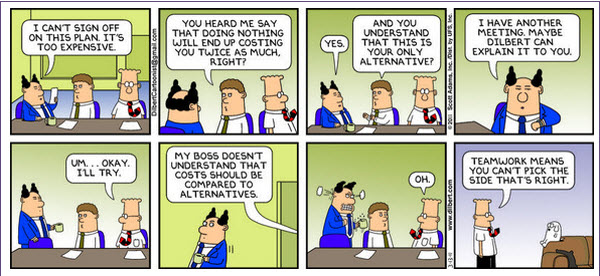
5 Ways To (Re)Evaluate and Improve Your Marketing Strategy
The first time you write your marketing plan, it’s an inspiring process. You’ve laid out this well-thought-out strategic roadmap that will lead you to business success, and you can’t wait to implement it. In some senses, you expect it to be a cakewalk. However, after a year, or maybe even just six months, you find yourself so focused on just “doing” things, that you forget all about the clear, strategic plan that you had initially laid out. You’re focusing more on keeping your head above water with things like “managing” social media accounts and you forget all about how to utilize them to your benefit – just like you had laid out in the marketing plan.
This happens to marketers everywhere, and if this sounds like you, it’s time to evaluate (and/or re-evaluate) your marketing plan. Here are 5 tips on how to get started:
1. Everything Must Trickle Down From Your Vision
In this post, we talk about the importance of having a clear vision in your marketing plan. This vision will give you the direction of what you should be evaluating in order to figure out how you should be defining success in your plan. For example, Disney’s vision is to “make people happy” (this is not necessary the vision written from a marketer’s perspective, but it’ll do as an example), and thus, one of their marketing goals could be to “increase the amount of people visiting Disneyland by 5% in the next quarter”. Assuming that Disneyland makes people happy, the more people that visit Disneyland, the more people they make happy.
Evaluate by asking yourself:
• Are my plan’s goals aligned with the vision?
• Do they trickle down directly or do they achieve a different purpose?
2. Ensure Your Goals Are Clear and Measurable
Building off of the example Disney goal of “making people happy”, you can quantify the goals that come from your vision and make them measurable. The goal of “increasing the amount of people visiting Disneyland by 5% in the next quarter” is very clear and measurable. Achieving the goal is black or white and offers no opportunity for confusion.
*Read about S.M.A.RT. goals to refine your goal-writing abilities
Evaluate by asking yourself:
• Have I made your goals measurable – are they in any way vague and/or confusing for staff or stakeholders?
• If so, how is the progress – am I meeting my marketing goals?
• Is my current measurement system effective?
3. Sales, Leads, Loyalty, or Brand Clout?
Your marketing plan should also clearly define what your marketing priorities are – it’ll help guide which budgets need more focus and which need less attention. Depending on whether you want to build sales, leads, loyalty, or brand clout, here are some examples of what you could be measuring:
• Qualified website traffic and leads (leads)
• Sales and revenue numbers (sales)
• Customer engagement numbers and examples (loyalty)
• Social following and newsletter subscribers (brand clout)
Evaluate by asking yourself:
• Is building leads, sales, loyalty, or brand clout most aligned with my marketing plan’s vision?
• Once I’ve decided on my priority, how do I plan on refocusing my resources (if at all)?
4. Formalize Your Qualitative Evaluation
Quantitative evaluation is necessary to keep you and your team objective about your results, but utilizing qualitative assessments can also be very valuable for general insight. For Disney, a unique survey asking about something as unquantifiable as “happiness” may not provide accurate results, but pair that analysis with the number of #Disney tweets that show some sort of happiness – whether it be photos with smiles in them or some other sort of measurement – and it can be the workings of a very valuable (and interesting!) qualitative analysis. Another avenue is asking internal staff their thoughts on how certain marketing actions are progressing – especially the sales team who are on the ground in front of the customer and can provide some valuable primary insight. These ideas – some of which are quantitatively-based – still aren’t going to be accurate enough for any research paper, but by formalizing this qualitative analysis and coming up with enough information to write a report, you can learn a lot about your brand and what your next steps might be.
Evaluate by asking yourself:
• What are all the creative ways I can be evaluating the marketing plan’s actions with regards to my vision?
5. Set “Trigger” Milestones
“On-the-fly” although sometimes necessary, can be very dangerous. Your marketing plan should be a strategic road map that leads to your plan’s vision, but when do you know it’s time to move to the next phase? Lay out opportunities for “little wins” and celebrate them like any milestone along the way to your ultimate goal, but make sure you include “trigger” milestones that dictate what the next step, phase, or milestone will be, or else you’ll feel like you’re doing the same thing over and over again without progression.
• Does your plan have a long-term objective in mind (By long term, I mean 3-5 years at least)?
• When and where are the “trigger” milestones that set into effect the next step, phase, or milestone of your plan?

Dilbert explains the cost of doing nothing
Remember That Your Marketing Plan is a Living Document
These 5 ways can help you (re)evaluate and improve your marketing plan right now, however, questions like “Are my resources being spent most efficiently?” or “Can a simple shift lead you and your staff closer to the vision?” are questions you should be asking yourselves on a constant basis. Remember that every plan will have mistakes, and the implementation of the plan will also include mistakes – this is all good and normal. However, the evaluation, analysis, and correction of those mistakes is what can set your organization apart.
If you liked this article, please check out some related links of ours:
– How To Build A Tribe Of Brand Followers
– Market Segmentation Benefits: The Beautiful Irony Of A Bullseye Target
– The Media Buyer Strategy: The World is Your Canvas
If you want to learn more about specific key elements of an effective marketing plan, read our 50+ page booklet on How to Write A Strategic Marketing Plan That Yields ROI – complete with explanations




